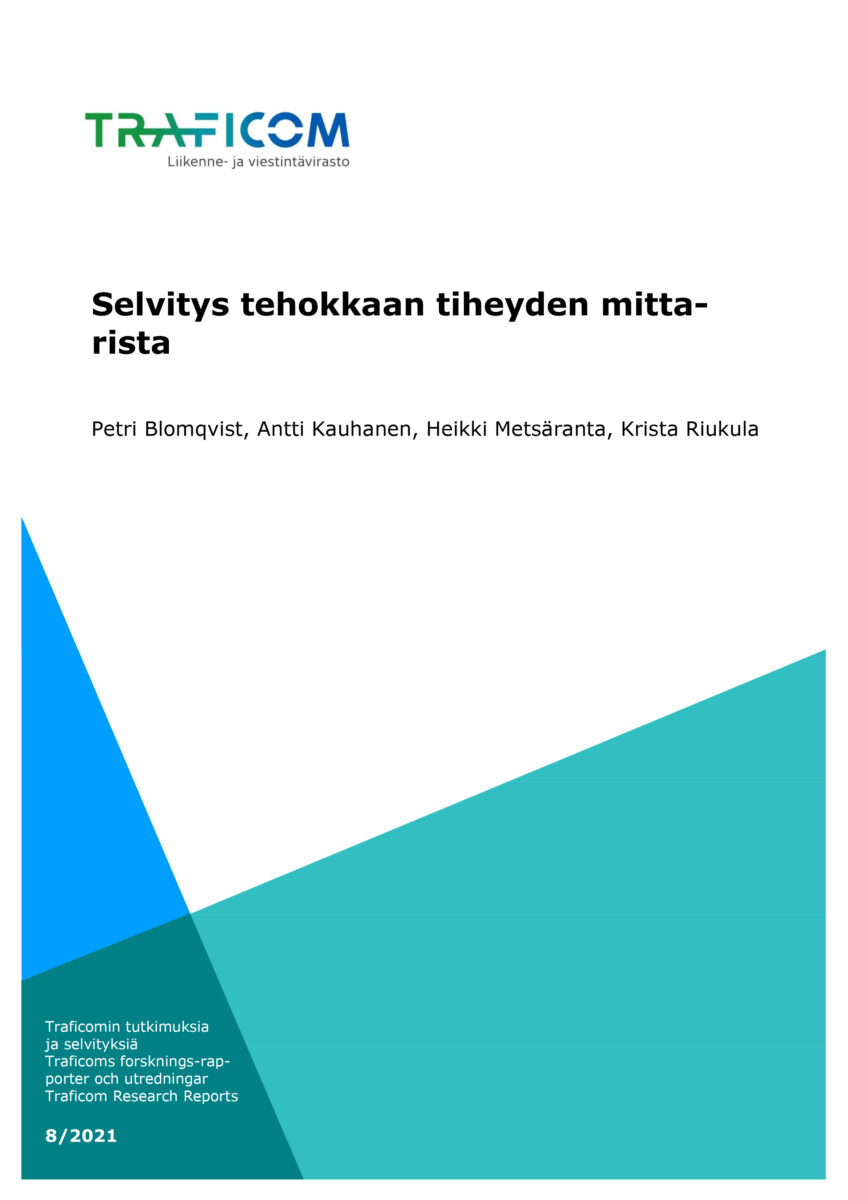
Liikennejärjestelmän kehittämisen taloudellisia vaikutuksia arvioidaan investointihankkeiden yhteiskuntataloudellisen kannattavuusarvioinnin yhteydessä. Laajemmat taloudelliset vaikutukset tarkoittavat toimenpiteiden suorien vaikutusten synnyttämiä talousjärjestelmän muutoksia, jotka voivat edistää tuottavuutta parantavaa kasautumista, työmarkkinoiden toimintaa, kilpailun tehostumista tai kiinteistömarkkinoiden toimintaa. Näiden vaikutuskanavien kautta kehittämistoimet voivat lisätä alueiden taloudellista hyvinvointia enemmän kuin mitä kannattavuusarvioinnissa on määritetty suorina liikennemarkkinoilla syntyvinä hyötyinä.
Tässä selvityksessä on keskitytty kasautumisvaikutuksiin. Työssä on määritelty Suomeen soveltuva tehokkaan tiheyden mittari, jonka avulla voidaan kuvata taloudellista kasautumista. Mittarin määrittely on yksi vaihe kasautumisvaikutusten arvioinnin kehittämistä ja osa liikennejärjestelmän laajempien vaikutusten arvioinnin tutkimus- ja kehityskokonaisuutta. Työhön on sisältynyt katsaus aiheen tutkimuskirjallisuuteen, tehokkaan tiheyden mittarin määrittely, parametrien estimointi liikennetutkimusaineistolla sekä mittarin testaus. Tutkimus- ja kehitystyön seuraavasta vaiheesta eli tuottavuusjoustojen estimoinnista esitetään alustava suunnitelma.
Suomeen soveltuvaksi tehokkaan tiheyden mittariksi suositellaan toimialaryhmät erottelevaa mallin muotoa, jonka tekijöitä ovat kulkutapaosuuksin painotettu alueiden välisten työperäisten matkojen matkavastus, alueiden työpaikkamäärä, estimoitu vaimennusparametri ja toimialaryhmäkohtaiset kertoimet. Tehokas tiheys tulisi määrittää mahdollisimman tarkalle aluejaolle ja yhdistää tarvittaessa suurempaan aluejakoon työpaikkojen määrän suhteessa.
Selvityksen ohjausryhmään ovat kuuluneet Tuomo Suvanto (pj.), Hannu Kuikka, Taru Pakkanen, Virpi Pastinen ja Anna Pätynen Liikenne- ja viestintävirasto Traficomista, Taneli Antikainen Väylävirastosta sekä Lauri Vuorio Helsingin seudun liikenne -kuntayhtymästä. Ohjausryhmään kokouksiin on osallistunut myös Niko-Matti Ronikonmäki liikenne- ja viestintäministeriöstä. Selvitystyön ovat tehneet Heikki Metsäranta ja Petri Blomqvist Ramboll Finland Oy:stä sekä Krista Riukula ja Antti Kauhanen Elinkeinoelämän tutkimuslaitoksesta.
This study defined an indicator for effective density suitable for Finland. The definition of the indicator is one of the phases in the development of the assessment of agglomeration impacts and part of a research and development project focusing on the assessment of the wider economic impacts of the transport system. The study included a review of relevant research literature, the definition of an indicator for effective density, the estimation of parameters using transport research data and the testing of the indicator. In addition to this, a preliminary plan is presented for the next phase of the research and development work, which will be the estimation of output elasticities.
According to studies, the best method for describing agglomeration is effective density. Issues that need to be resolved in the definition of an indicator for effective density are the definition of the catchment area, the attribute for economic mass, the measure of distance and the impact of distance (decay). The catchment area should be defined as precisely as possible when calculating effective density, as agglomeration impacts decay rapidly with distance. Economic mass is defined generally based on the number of jobs. The recommended measure of distance is generalised cost for travel. The choice of decay rate is an empirical question of which form best corresponds to observations. The assessment of agglomeration impacts has been officially incorporated into the assessment of the wider economic impacts of infrastruc-ture projects in the United Kingdom and based on the same model in some other countries. However, agglomeration and its assessment are still subject to ongoing research in the United Kingdom.
The indicator for effective density recommended for Finland is a model that differentiates industry groups, the factors of which are the generalised cost for work-related travel emphasising the relative shares of different modes of transport, the number of jobs in the area, the estimated decay parameter and industry group specific coefficients. Effective density is defined for a precisely defined catchment area and extended, if necessary, to a larger catchment area in relation to the number of jobs.
The next step of the research and development project focusing on the assessment of agglomeration impacts will be the definition of industry-specific output elasticities via the estimation of an output function. The estimation of the output function should preferably be carried out not only in the Helsinki region, but in the Turku region, for example, and at the national level as well to determine regional differences. The project should include a sensitivity analysis of the decay parameter and examine the impacts that changes in the generalised cost of different modes of transport have on output.
Alongside this research, agglomeration impacts are examined in accordance with the Ministry of Transport and Communications’ examination framework with the help of changes in the generalised cost for work-related travel and primarily qualitatively. The aim of the development of agglomeration impact assessment is to incorporate the method and its applications into the assessment guidelines for transport and land use planning.
Arkadiankatu 23 B
00100 HELSINKI
Vaihde ja vastaanotto avoinna arkisin klo 8.30–15:30.
+358 (09) 609 900